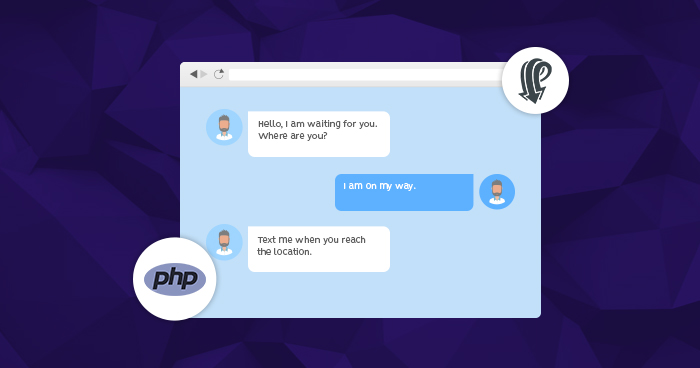Real-time communication between members in an organization is an essential element of effective operations. Whether it’s a private conversation between two people or a group chat between many people, having the option to easily chat in real-time can be a major time-saver.
For organizations using the popular and powerful open-source scripting language PHP, adding real-time chat functionality to their website does not have to be a nightmare. There are several different ways to implement real-time chat in PHP, all of which require a bit of technical know-how but can be be accomplished in a relatively short amount of time.
In this article, we’ll discuss the different ways to implement real-time chat in PHP and discuss the pros and cons of each. We’ll also provide examples of both server and client-side code to give you a better idea of how it all fits together.
Overview of Real-Time Chat
Real-time chat is a type of online communication that enables participants to communicate in real-time. This is different from the more traditional type of communication, which requires users to wait for a response from the other side before they can continue the conversation.
Real-time chat usually involves a server and a client. The server is responsible for hosting the chat room and managing the messages that are sent. The client can be a web page or a mobile app that enables users to participate in the chat.
Real-time chat can be used for a variety of purposes, including customer service, internal communication, online collaboration, and more. It can also be used to facilitate group conversations and make it easier for members of the same organization to collaborate by easily sharing files and documents.
Types of Real-Time Chat
There are several types of real-time chat that can be implemented in PHP. Here are some of the most popular:
-
WebSocket Chat: WebSocket is an advanced technology that enables two-way communication between a server and a client. It is perfect for real-time applications and can be used to implement real-time chat in PHP.
-
AJAX Chat: AJAX (Asynchronous JavaScript and XML) is a powerful web technology that enables the creation of interactive web applications. It is perfect for implementing real-time chat in PHP, as it enables you to create a web page that will continuously update to show new messages.
-
WebRTC Chat: WebRTC (Real-Time Communications) is a more modern technology that enables real-time communication between two peers via a browser. It is also known as peer-to-peer communication and can be used to implement real-time chat in PHP.
-
Long-Polling Chat: Long-polling is an technique that involves making multiple requests to the server at regular intervals. The server will respond with an updated message once it detects an event has occurred. Long-polling can be used to efficiently implement real-time chat in PHP.
Pros and Cons of Different Chat Types
Each of the chat types we’ve discussed have their own benefits and drawbacks. Here are some of the pros and cons of each:
-
WebSocket Chat: The biggest benefit of using WebSocket for real-time chat is that it does not require the page to be reloaded for new messages to appear. However, it does require a server and can be more difficult to set up.
-
AJAX Chat: AJAX is quite easy to implement compared to other techniques and does not require a server. However, it does require the page to be reloaded to show new messages, which can lead to performance issues.
-
WebRTC Chat: The biggest benefit of using WebRTC for real-time chat is that it does not require a server and does not require the page to be reloaded for new messages to appear, which makes it a great option for speedy real-time communication. The downside is that it is only available on modern browsers, so it may not be suitable for all users.
-
Long-Polling Chat: Long-polling is a great option for real-time chat as it is more efficient than AJAX. However, it does require more server resources than other methods, so it may not be ideal for larger organizations.
Examples of Chat Code in PHP
Before we wrap up, let’s take a look at some examples of code that you can use to implement real-time chat in PHP.
Server-Side Code
The following code is an example of the server-side code for a real-time chat in PHP. This code would be placed in a file on the server, which would handle communication between clients and the server.
$socket = socket_create(AF_INET, SOCK_STREAM, 0);
$result = socket_bind($socket, '127.0.0.1', 8080);
$result = socket_listen($socket, 3);
$clientSocket = socket_accept($socket);
while (true) {
$message = socket_read($clientSocket, 1024);
echo $message;
socket_write($clientSocket, $message);
}
socket_close($clientSocket);
socket_close($socket);Client-Side Code
The following code is an example of the client-side code for a real-time chat in PHP. This code would be embedded into a web page to enable communication between the client and the server.
$socket = socket_create(AF_INET, SOCK_STREAM, 0);
$result = socket_connect($socket, '127.0.0.1', 8080);
$message = '';
while ($message != 'exit') {
socket_write($socket, $message);
echo socket_read($socket, 1024);
$message = readline();
}
socket_close($socket);Real-time chat is an essential element of any website, and implementing real-time chat in PHP can be relatively easy. In this article, we’ve discussed the different types of real-time chat that can be implemented in PHP and the pros and cons of each. We’ve also provided some example server and client-side code to help you get started. With a bit of technical know-how, you can easily add real-time chat functionality to your website.

